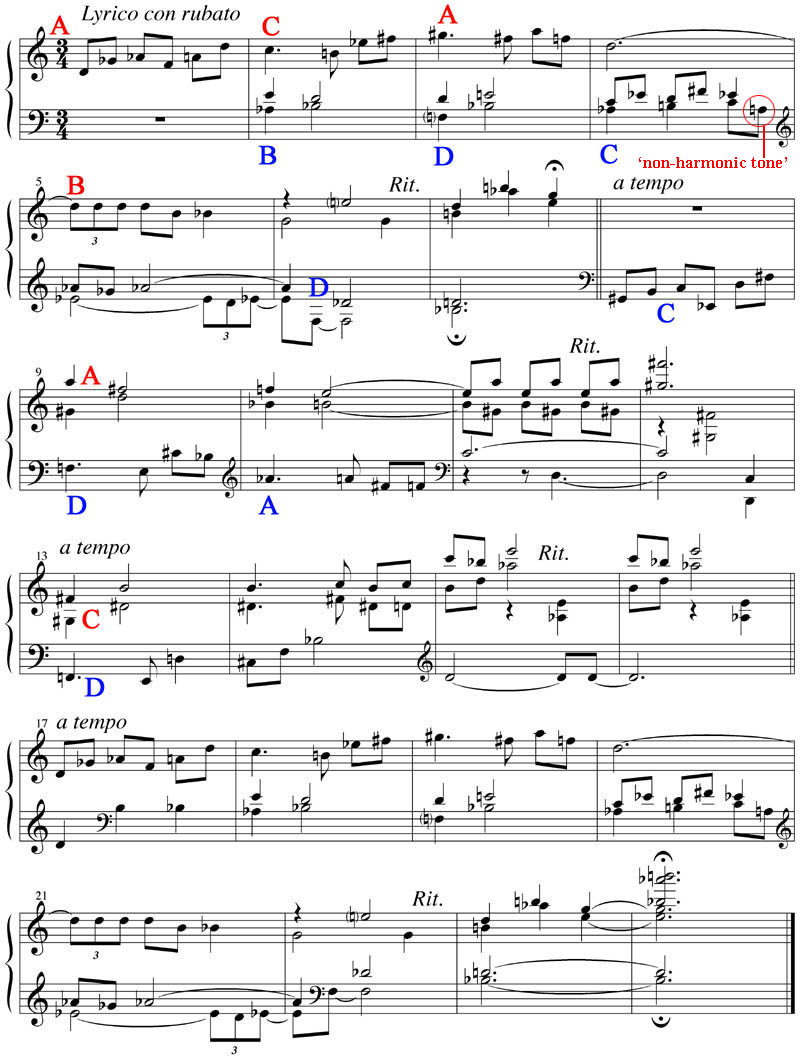1. Developing a Scale. One method for creating a new scale that repeats each octave is to map out a succession of intervals that can be used in either an ascending or descending mode. Although a composer can of course choose one form over the other, the possibilities open up exponentially through a combination of their usage. In our piece, we will use a seven note scale, in two forms, based on the interval succession of a minor 3rd, minor 2nd, major 2nd, minor 2nd, minor 3rd, and major 2nd.
2. Transpositions. Just as in tonal composition, we can transpose the scale to each step in the chromatic field. This allows the composer to adopt Common Practice Era concepts such as modulation into the new piece, or simply act as a pool of scalar material from which to draw melodic and harmonic ideas from. In our ternary composition, we have chosen the latter, but have limited ourselves to using both forms of two transpositions, a tritone apart. We have labeled each form with a letter so the student can follow how we have written the piece shown in the analysis below.
3. Writing the Piece. The Common Practice ternary form has tonal constraints that are relaxed to a significant degree here. Instead of key regions, the character each section here is defined by the location of the melody. Our first section is distinguished by a treble melody accompanied by two voices in the bass, while the second section is contrasted by reversing this format. Cadences are further distinguished by allowing for a more homogeneous texture with a denser chordal basis.
Regarding harmony, similar to how in the tonal realm we can choose from a tertian or quartal vocabulary, we can interpret the best usage of the scale that we have devised. Because of the somewhat angular properties of the present scale we needed to develop musical materials appropriately. In that frame of mind, our melodic ideas are largely non-tonal accompanied by harmonies that implement dissonance rather freely. In terms of what scale forms to use and when to use them, our method in this piece was to allow each form to move freely from one to the next through a common tone (similar to the mannerisms of late 19th/early 20th century composers such as Max Reger, Richard Wagner, and Arnold Schönberg, that feature in their compositions rapid successions of modulations through many tonal centers). In some ways, this approach to using synthetic scales is more akin to the notion of 'constellations' of pitch groups from which the composer can draw materials for development, and less the traditional practice of applying a hierarchy to the scale degrees with which to orient a single key center.
In our piece, the first section uses complementary scale forms that change from bar to bar, while the second allows for a more sustained presentation of each of the forms, including three bars (10-12) wherein both treble and bass share the same transposition. Also note the 'non-harmonic tone' (a pitch not featured in form C) in bar 4: here we simply felt it was the right sound for that moment in the piece. Once again, the student should not feel overtly constrained to follow any system or rule when the need for expression takes precedence.
mp3 download (piano version)





